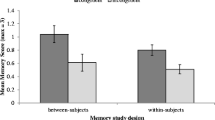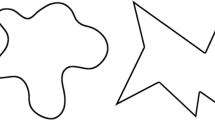Abstract
Sound-symbolism is the idea that the relationship between word sounds and word meaning is not arbitrary for all words, but rather that there are subsets of words in the world’s languages for which sounds and their symbols have some degree of correspondence. The present research investigates sound-symbolism as a possible route to the learning of an unknown word’s meaning. Three studies compared the guesses that adult participants made regarding the potential meanings of sound-symbolic and non-sound symbolic obsolete words. In each study, participants were able to generate better definitions for sound-symbolic words when compared to non-sound symbolic words. Participants were also more likely to recognize the meanings of sound symbolic words. The superior performance on sound-symbolic words held even when definitions generated on the basis of sound association were eliminated. It is concluded that sound symbolism is a word property that influences word learning.
Similar content being viewed by others
References
Andrews S. (1997). The effect of orthographic similarity on lexical retrieval: Resolving neighborhood conflicts. Psychometric Bulletin & Review 4, 439–461
Benson J., Nasser F. (1998). On the use of factor analysis as a research tool. Journal of Vocational Education Research 23, 13–33
Bloomfield L. (1933). Language. Holt, Rinehart and Winston, New York
Bolinger D. (1950). Rime, assonance, and morpheme analysis. Word 6, 117–136
Brennan R.L. (1992). Elements of generalizabilty theory. ACT Publications, Iowa City
Brown R.W. (1958). Words and things. The Free Press, Glencoe, IL
Brown R.W., Black A.H., Horowitz A.E. (1955). Phonetic symbolism in natural languages. Journal of Abnormal and Social Psychology 50, 388–393
Carroll J.B., Davies P., Richman B. (1971). Word frequency book. American Heritage Publishing Co., Inc., New York
Cassidy K.W., Kelly M.H., Sharoni L.J. (1999). Inferring gender from name phonology. Journal of Experimental Psychology: General 128, 362–381
Cassidy K.W., Kelly M.H. (2001). Children’s use of phonology to infer grammatical class in vocabulary learning. Psychonomic Bulletin and Review Journal 8, 519–523
Choi S., Gopnik A. (1995). Early acquisition of verbs in Korean: A cross-linguistic study. Journal of Child Language 22, 497–529
Ciccotosto N. (1991). Sound symbolism in natural language (Doctoral dissertation, University of Florida, 1991) Dissertation Abstracts International, 53, 541.
Cohen J. (1968). Weighted kappa: nominal scale agreement with provision for scaled disagreement or partial credit. Psychological Bulletin 70, 213–220
Crick, J. E., & Brennan, R. L. (1984) GENOVA A general purpose analysis of variance system [Computer software and manual].
Dale E., O’Rourke J., Barbe W.B. (1986). Vocabulary building: A process approach. Zaner-Bloser, Columbus, OH
Durso F.T., Shore W.J. (1991). Partial knowledge of word meanings. Journal of Experimental Psychology: General 120, 190–202
Ervin S.M. (1961). Changes with age in the verbal determinants of word-association. American Journal of Psychology 74, 361–372
Farrar W.T., Van Order G.C., Harmouz V. (2001). When SOFA primes TOUCH: Interdependence of spelling sound and meaning in “semantically mediated” phonological priming. Memory & Cognition 29, 530–539
Grambs D. (1994). The endangered English dicitonary. W.W. Norton & Company, New York
Halliwell J.O. (1850). A dictionary of archaic and provincial words, obsolete phrases. proverbs, and ancient customs. John Russell Smith, London
Hinton L., Nichols J., Ohala J.J. (1994). Sound symbolism. Cambridge University Press, New York
Kelly M.H. (1992). Using sound to solve syntactic problems: The role of phonology in grammatical category assignments. Psychological Review 99, 349–364
Kess J.F. (1992). Psycholinguistics: Psychology, linguistics, and the study of natural language. John Benjamin Publishing Company, Victoria, Canada
Laird C.G., Agnes M. (1999). Webster’s New World Roget’s A–Z thesaurus. Macmillan USA, New York
LeCron Foster M. (1978). The symbolic structure of primordial language. In Washburn S.L., McCown E.R. (eds). Human evolution biosocial perspectives. The Benjamin/Cummings Publishing Company, Merlo Park, California, pp. 77–122
MacKay C. (1879). The lost beauties of the English language. Chatton & Windus, London
Malkiel Y. (1990). Diachronic problems in phonosymbolism. J. Benjamin Publishing Company, Philadelphia
Markel N.N., Hamp E. (1960). Connective meanings of certain phoneme sequences. Studies in Linguistics 15, 41–61
McCure, K. (1985). The internal structure of Indonesian roots. Badan Penyelenggara Seri Nusa, Universitas Katolik Indonesia Atma Jaya.
Nagy W.E., Anderson R.C., Herman P.A. (1987). Learning word meanings from context during normal reading. American Educational Research Journal 24, 12
Nagy W.E., Herman P.A., Anderson R.C. (1985). Learning words from context. Reading Research Quarterly 20, 233–253
Nuckolls J.B. (1999). The case for sound symbolism. Annual Review of Anthropology 28, 225–252
O’Seaghdha P.G., Marin J.W. (1997). Mediated semantic–phonological priming: Calling distant relatives. Journal of Memory & Language 36, 226–252
Rhodes R.A., Lawler J.M. (1981). Athematic metaphors. Chicago Linguistic Society 17, 318–342
Sapir E. (1929). A study in phonetic symbolism. Journal of Experimental Psychology 12, 225–239
Saussure F.D. (1959). Course in general linguistics. Philosophical Library, New York
Schwanenflugel P.J. (1991). Why are abstract concepts hard to understand. In Schwanenflugel P.J. (eds). The psychology of word meaning. Lawrence Erlbaum Associates, Hillsdale, NJ, pp. 223–250
Schwanenflugel P.J., Stahl S.A., McFalls E.L. (1997). Partial word knowledge and vocabulary growth during reading comprehension. Journal of Literacy Research 29, 531–553
Sereno J.A. (1994). Phonosyntactics. In Hinton L., Nichols J., Ohala J.J. (eds). Sound Symbolism. Cambridge University Press, New York, pp. 263–275
Shore W.J., Durso F.T. (1990). Partial knowledge in vocabulary acquisition: General constraints and specific detail. Journal of Educational Psychology 82, 315–318
Author information
Authors and Affiliations
Corresponding author
Rights and permissions
About this article
Cite this article
Parault, S.J., Schwanenflugel, P.J. Sound-symbolism: A Piece in the Puzzle of Word Learning. J Psycholinguist Res 35, 329–351 (2006). https://doi.org/10.1007/s10936-006-9018-7
Published:
Issue Date:
DOI: https://doi.org/10.1007/s10936-006-9018-7




